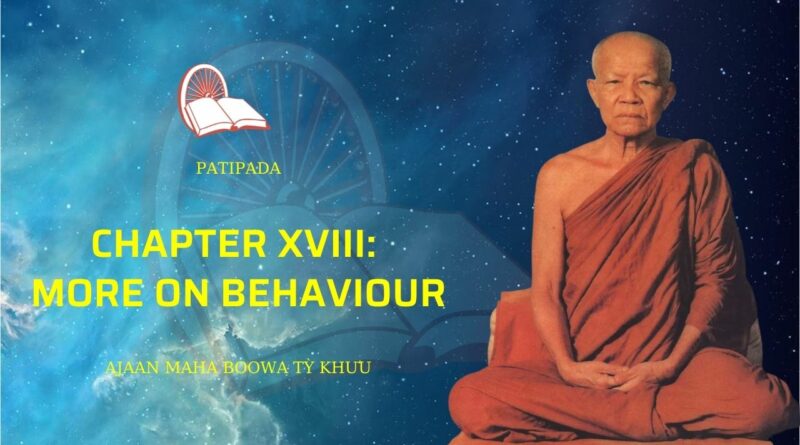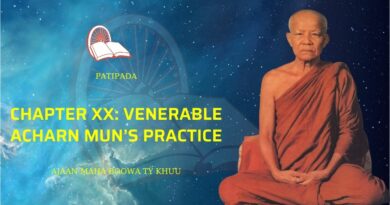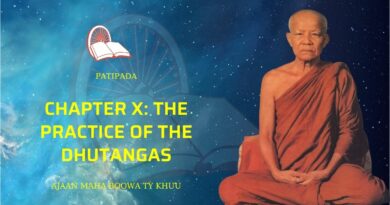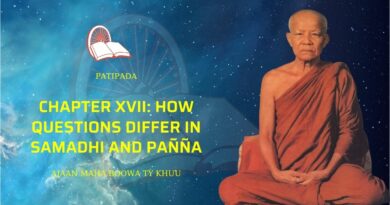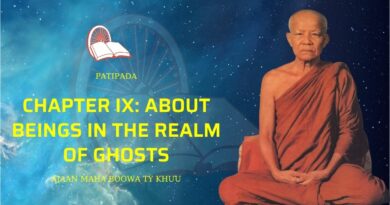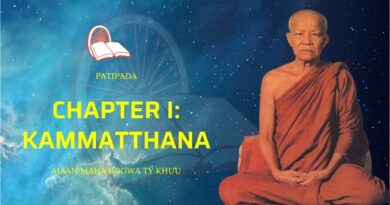PATIPADA – CHAPTER XVIII: MORE ON BEHAVIOUR
The Dhamma conversations which occur amongst Kammatthana Bhikkhus are bound to bring up various problems arising from both samadhi and pañña of a kind that involves both inseparably. This is why I have brought in some of the stories which should be thought about as examples of some of the things which some people have come across and experienced from their practice, such as the things that happened to the Nun Khun Mair Kaew. I have only brought in those stories which are isolated cases, and not those which are long and involved such as occurs amongst those who themselves do the practice. For each case is individual and dependent on the inherent characteristics of each person concerned, and they differ considerably. So I have always found these Dhamma conversations to be very varied and involved, in accordance with the basic level of those concerned, who do the practice and have experienced various aspects of it, each in their own way.
What is the nature of the problems which are associated with samadhi that has “integrated” down, and which arise at that time? Having “integrated down”, it stops at one of the levels of samadhi such as khanika (momentary), upacara (close by) or appana (full attainment). When it integrates, goes down and stops at the level of upacara, the citta goes out, contacts and acknowledges various things, and this is the type of samadhi which tends to bring up more problems than any other type. Some of these problems are the source of questions which those who practise may have come across in some cases, which they then bring up in conversation with their companions, or with a teacher whom they respect and have faith in, because they need the answer to them. Those others who also have similar problems, or problems associated with various different levels of pañña, then bring them out for discussion, so as to check their own knowledge and understanding to make sure that it is right on both sides. In other words, on the side of the one who has come to learn and ask questions to make sure there is no danger of his being at fault in all the problems and questions which have been discussed. Secondly, on the side of the one who gives the teaching, he can feel confident that the questions that the others ask him are leading in the direction and are for the purpose of getting rid of the kilesas; and also, that they are instrumental in promoting investigation into all sorts of things that happen, wherever it is necessary.
Problems concerning the overcoming of obstacles obstructing investigative thoughts which are for the purpose of progressing past difficulties step by step, are very important. When someone does such an investigation: what is the citta attached to? and, how should he investigate to penetrate the problem and go beyond it? The one he talks to or the Acariya must try to point out and make clear a method for curing such a problem, until he has understood it sufficiently well so that he can use that method to practise in the right way and steadily get results from it.
Any of the problems which arise at the various levels of samadhi and pañña are liable to cause a lot of worry and concern to the one who has them, which can be quite noticeable. Not only must he try to work out his problems for himself, but he must also depend on those Venerable Ones who have already gone this way, to consult with from time to time, so that he may be quite sure that the practice and problems which he has worked out for himself and consulted others upon, are firmly embedded in his heart with all the reasons for them. For this reason, Kammatthana Bhikkhus are likely to get together for talks on Dhamma very frequently, due to the fact that their practice is going on all the time.
When Bhikkhus talk about things which are personal and vital, things which touch upon the true nature of Dhamma and its meanings, they generally do so just two together. This kind of conversation is bound to be a special occasion and rarely occurs. For when they meet each other, each of them longs to hear about the fruits of the practice of Dhamma which the other has in his heart. Their conversation will then probably start at the beginning of their practice, or from where they left off in their last conversation together. In the first case one of them tells his own story from the beginning, right through to the present state of his citta. Afterwards, if it is not yet suitable for the listener to ask and hammer out the problems which he has in mind, he will start out to relate his own story to the other person, from the beginning, until he has covered everything which he knows and which has happened up to the present. After that, if either of them has doubts about any aspect of Dhamma, or about uncertainties which are hidden in the Dhamma which the other has related, they will bring them up and test their understanding further to make sure of it, until they both accept it and are in full agreement with each other.
Furthermore, if the answer to any of the problems which were brought up for discussion were found to be not entirely satisfactory to the one who was most advanced in his practice, he would give an authoritative explanation. If it is necessary to correct and alter the way that the other party is going, he will also explain how he should go about correcting his practice. If he should stop and not go on doing whatever it is that is wrong any more because it will bring him harm, the one who is explaining will point it out to him and give the reasons why, until he understands.
Therefore, I feel that Dhamma conversations which are concerned with the practice are a great boon and blessing to both of those involved. Because each will listen to the other with close attention from beginning to end while he is talking, and each gains by following Dhamma (Dhammanusarana) from each other, which acts as something to be thought about and practised and something to gain more value from than one can say. Both of them are bound to remember each other with a great and unfolding sense of gratitude for the rest of their lives — it could not be otherwise.
While they are discussing Dhamma together, sometimes there may be a bold and intrepid Bhikkhu, such as the present writer, who creeps up secretly to listen to what they say although he has no business to do so. To say that this is contrary to the Vinaya rule which makes it an offence for a Bhikkhu to creep up secretly and listen to Bhikkhus who are quarrelling together contentiously does not apply to the kind of discussion we are considering here. It therefore leaves room for Bhikkhus, of the kind who have no business to do so, to have a short cut to find and learn Dhamma in this way. Such a time is a golden opportunity to hear Dhamma which is pure gold for both of those who take part in the discussion as well as for anyone who creeps up secretly to listen; an opportunity which they would never get elsewhere. For this is the time when both parties open up and bring out the Dhamma from their hearts to reveal that which is their highest achievement to each other’s ears and hearts. Those who creep up and listen to them also enjoy stealing the Dhamma that overflows from them, so that it can become their own highest achievement in the future. It seems that there have been very few sages of the kind who “steal” Dhamma in the history of Buddhism. But there must have been some in all ages from the time of the Buddha up to the present day, and especially amongst those who practise the way. Because what they hear is something which is very difficult and rare to come across in the usual Buddhist meetings that take place in many places. This type of Dhamma is truly not for such meetings — and not the kind which should be brought out in public. For it is the “personal Dhamma” which dwells just within each individual and which can only be brought out when the right occasion for a discussion, at the right place and time and with the right people who inspire confidence, arises.
A Dhamma conversation between those whose cittas and Dhamma are at a high level can take several hours before each one finishes talking. Because it involves their methods of practice, their places for doing the practice and the overcoming and curing each one of their important problems, of which each of them has had many. And the Dhamma which they understand at each level after they have managed to cure each important problem is a long story and so involved and profound as to be beyond a full explanation of what happened to the citta, even though it is so important. It takes a long time for each of them has to put all the essential facts of what happened to him into his explanation, which makes it both lengthy and involved. This is necessary, because it is essential for them to relate all the crucial points in full so that the other party may understand and assess whether the reasons given are sufficient and valid or contradictory in any way. This in turn comes from the fact that the results of Dhamma at every level that arises from the practice which is done, must display its causes; in other words, the way in which one acts determines the way one goes. Therefore, a Dhamma discussion must include the causes as an inseparable pair with the results. Whichever of them knows and whichever tells his story, they are bound to bring in the causes, which are the ways of behaviour and practice as confirmation, and the results which arose must display a conformity with those causes.
That which is most valuable to listen to and which goes to one’s heart, never to be forgotten, is the story of the time when the citta of the speaker turned itself around by the skilful means of sati–pañña, which was fully equal to the deceptive tricks of every kind of kilesa, and steadily progressed beyond them with that level of sati–pañña which is up to all the tricks and devious ways of sexual craving (raga–tanha). Then this kind of citta which is imbued with kilesas of this kind is cut off and can no longer continue to arise from then on. Then finally, the citta which has reached this level, full of strength and fully developed, overturns avijja, which has been the “tap root” of the round (vatta) of samsara, and disposes of it. These, which are the most special and wonderful Dhammas, are rarely heard by anyone throughout their life. For what generally happens both with ourselves and others, is that we die empty handed, without ever having heard the sound of the Venerable Ones who have done the practice and known this kind of Dhamma entering our ears. All we hear is the sounds of empty talk and vanity which weigh us down, destroying our health and well being both physical and mental; sounds such as we and you hear all the time nowadays until we are sick and tired of them. But even then we cannot refrain from speaking and hearing them because they are like food left over at the bottom of the pot — if we don’t eat it, what will we eat?
But in Dhamma talks between these Bhikkhus which we have been discussing above, they talk in ways that come naturally to them in what is associated with the citta in the sphere of practice. They do not talk about having reached this stage or that level of Dhamma. In fact when they talk together, none of them ever claims that he has reached this or that stage, such as the attainment of Stream-entry (Sotapanna) up to Arahatta. All of them seem naturally to follow the ways of the forest rather than the ways of those who have advanced in society and become clever in its conventions.
Amongst those who practise the way, if they hear any one of them speaking like people in the world who have developed materially, saying that they have attained this or that level, what should their companions think? They are bound to feel uncomfortable and out of harmony with such a Bhikkhu, who acts in such strange and peculiar ways. Because of this kind of behaviour, they would immediately start to lose confidence in him. For none of them would act like that even though they are also aspiring for Dhammas at those levels with a full-hearted commitment and may in fact be able to talk about them. They are like this because they see that they are the highest Dhamma within the field of Dhamma as they conceptualise it. Therefore they uphold it as the highest and would not demean it by putting it into words and speech. But their aim is to make contact with it in the heart by means of the various aspects of practice, rather than displaying such offensive behaviour for the world to see.
There are however, those who speak out in the belief that they have attained some higher state, which comes from a lack of circumspection, but their intention is still good. Although there are also those who speak out, saying that they know the way to go wandering about on the moon or Mars and other such things. This comes from motives that are coarse and evil and lacking in any virtue and such people should not be within the circle of those who practise the way. The former kind may be forgiven and they should be helped in any way that is possible, in fact the effort should be made to give them the greatest assistance that is available. The other Bhikkhus do not look on this type with distaste or loathing, but rather with compassion and they give their advice with metta. Because it is quite possible for this kind of thing to happen amongst those who practise the way. For when they have never gone this way before they are liable to gain knowledge as well as delusion, which happens with all of us.
This sort of thing happened here quite recently and the story of it was told by a Bhikkhu who practises well and has very strong commitment to Dhamma. He said that he went to practise Dhamma in the hills and late one night when everything was quiet and peaceful he became very calm and quiet at about midnight. He thought that he had attained the goal and become an Arahant. So he took out his “snuff pipe” from his handbag and blew it as a whistle, “Piiid…” to call his companions who had gone to stay in the same location. They quickly came to him, concerned that something had happened and asked him why he had called them. He answered straightforwardly:
“I’ve attained (Enlightenment), it happened just now and felt compassion for you, so I blew my whistle to call you.”
Whether this was true or false they did not know at that time, but they thought to themselves:
“This whistle blowing attainment, what kind of thing is this? It’s too bizarre and peculiar”,
although neither of them felt sure enough to say anything about it.
The following night at about midnight, they again heard the whistle, loud and echoing about the hills. They thought to themselves:
“Blowing that whistle at this time, has he attained a state of madness — or what else now. Last night he attained the state of Arahant, so what else can he have attained this time? We don’t know, but this Arahant is a real pest.”
But they had to go and see because they had come as a group and it would have been wrong just to take no notice. When they got there they asked him:
“What have you managed to attain this time?”
The whistling Arahant then said:
“In fact I did not attain anything. It was a mistake last night, for just now I realised that they are still there, so I quickly blew my whistle to call you, so as to correct what I said yesterday and to let you know that there has been no attainment yet. In fact I was completely deceived by them and these kilesas are very clever. From now on I am going to discipline them most severely. That I could be so deceived by these kilesas makes me really angry.”
One of the others asked him saying:
“What happened last night and tonight is one thing, but why then do you have to talk about it so much? Is it that you don’t have any mindfulness in your heart, or what? I think that before long you will be a case of a Kammatthana madness.”
“I feel so ashamed about it now,”
he replied.
“But the kilesas had vanished and were quite silent. I thought that they were dead and I had to celebrate my victory with you, so I blew my whistle, see! But tonight they reappeared once again and they are not dead as I had thought. So I had to call you once again to let you know.”
When there is wrong understanding such as the foregoing, nobody takes it very seriously. It is amusing and something that they can get a good laugh out of. As for the latter type, they are loathsome and fearful. But those who want to go to the moon will, generally speaking, like this latter kind very much. This is why there always tends to be some lunacy hidden within the circle of those who practise the way and there is no way to cure it completely.
In particular, Venerable Acharn Mun was, as far as I know, never heard to speak of himself in connection with the Path and Fruition, saying that he had attained to such and such a stage or level — or even to imply this. I felt that he had great reverence for these stages and levels of Dhamma. Although he would talk and say things which accorded with the truth of Dhamma which arose within him, and even though it is written in the “Biography of Venerable Acharn Mun” that he had attained these states, he never made any such claims. It was just that the writer of the Biography who is rather foolish, wrote about him from his own understanding that came from listening to the Dhamma in his nature. My purpose in writing in this way in the Biography was to try and get the reader, or those who hear it being read out, to take it in, in a heart felt way. For even though readers have probably not reached that state, they can at least read about it or hear it as the heart’s ideal and be inspired and encouraged by it, and aroused out of their incessant pit of complacency.
Speaking about the skilful methods of sati–pañña in their adaptability to the kilesas and the course taken by the citta in breaking through and cutting down all the kilesas by various methods, which were the characteristics of behaviour of the greatest Teachers, and as an example, we may look to Venerable Acharn Mun, who is the owner of his own biography, in this present age. I cannot find any fault or flaw in him, but he was never heard to say such things as, “I have gone beyond this stage or that level of Dhamma….” Because the skill and perspicacity of those who establish the patterns of behaviour in this modern world do not display outwardly such things, as would be unseemly and would tarnish the good reputation of the Dhamma and Vinaya, the two things which represent the original Teacher (Sasada). This wise discrimination taught him to know the basic ground of the original Teacher and of himself, for he was a Savaka (one who listens and follows), and in the suppositions of the world (sammuti), the two are quite different. For a while he himself was still within sammuti, being still associated with the elements and groups (dhatu–khandha) which make up a person, even though his citta had already gone beyond and become free, it was necessary for him to maintain this way of behaviour as an example to other people in the future such as you and I, so that we may at least have a sense of shame in ourselves and in our hearts to prevent us from spreading such talk about in a way that has no good purpose. Until others who practise Dhamma become disgusted and repelled by the offensiveness of it against the ways of their society which still respects those conventions which are decent and virtuous.
In truth, those who practise Dhamma, who have a high level of Dhamma in their hearts and who are worthy of faith and respect just display this fact in their external activities for others to be able to know well enough to what extent they conform to the standards of the world and Dhamma, and there is really no need to make an announcement of any unseemly and repugnant claims. The world has always used discernment to assess what is good and bad, for in the world of people who are Buddhists, those who lead the way in upholding the religion are not just made up of stupid people, such that those who are truly wise and who have attained the Ariya lineage should blame them and make a broadcast of the religion. For those methods, which are truly good, harmonious and subtle, which are complete with all the techniques and Dhamma truths which they have always used to bring harmony and a joyous heart to their followers, have not yet been lost and have not yet vanished from the religion and those who practise the way.
There are still those methods that perpetuate the “flowers and fruit” which are pleasing, a joy to see and make for peace of heart in those who have seen them and admired them in the past, and they still exist in this present age. A good example of this is the story of Venerable Assaji who was one of the first Arahants and who taught Dhamma to Venerable Sariputta. He was a most humble and self-effacing follower (Savaka) of the Buddha, which was so right and proper for one who was known to have “conquered the outflows” (Jinasava) and in whose heart there remained no taint of worldly desires (lokamisa) at all. The gist of what he taught Sariputta at that time was as follows:
“This monk has only recently been ordained into the Dhamma and Vinaya and he has not got any extensive experience or knowledge. So he cannot reveal Dhamma to you that is very profound and wide in scope, but will give you a brief summary of the central principle.” Then he taught, saying: “All Dhammas arise from causes, and they cease because causes bring about their cessation. The Venerable Samana Gotama who is our prime Teacher (Sasada) revealed and taught us this.”
That is all he said, and the wise and perceptive Sariputta who was then a wandering religious mendicant (Paribbajaka) and was at the cross roads between his old faith and the way of the Buddha, knew the taste of Dhamma immediately, at that moment. He also grasped at the path of Buddhism which immediately went deeply into his heart. It was as though he were to make an exclamation, saying that he had found a completely reliable and trustworthy life-line to claim his attention, which came from the great virtue of Venerable Assaji Thera quite unexpectedly. All that was left of the original wandering mendicant after that, was his external appearance. As for the initiation as a Samana, which he had received from Venerable Assaji Thera, it was the first level of Ariya Savaka, as accords with the way of nature. But even so, the Paribbajaka Upatissa still did not know what the Samana status was of the Acariya who had caused the Ariya ground to arise in him. This was because Venerable Assaji had no interest in talking about himself — which would be just a lot of hot air coming from his mouth and would soon evaporate — unlike his talk of the truths of Dhamma which he gave to Upatissa, resulting in his gaining a satisfying refuge right then and there.
This is the Aryan custom of those who have come to the end of worldly ways and attachments (lokamisa), which are poison acting like bait that is dangerous to all us fish. So the ways in which they act towards the world are always quite wonderful and remarkable. The tone and manner in which Venerable Assaji revealed Dhamma to the wanderer Upatissa comes resounding and clear to the inner sense of hearing of us Buddhists, and even though it occurred more than two thousand years ago, it has not faded or lost its meaning with the passing of time. In addition, even though Upatissa had gained a new vitality and life leading to his becoming Venerable Sariputta the Savaka of the Buddha, he never became proud and puffed up in the way that people usually do. Even when he became the foremost of all the Savaka followers of the Lord, he always paid homage and the deepest reverence to the virtuous qualities of his Teacher. Moreover he was highly praised by the Lord, the Supreme Teacher (Parama–Sasada) who said of him that he knows and never forgets those who have helped him and been generous to him even in small ways. Like the case of the Brahmana Radha who received ordination as a Bhikkhu because Venerable Sariputta acknowledged that he remembered him once having given a ladle full of food in his bowl.
If we compare this with the ways of ordinary people in the world, they would never have recalled such a small incident in the same circumstances. Because the position of being the foremost disciple, the Buddha’s right hand man, which was a position, secondary only to the Lord Buddha himself would probably have made them forget or not bother about such a small, trifling matter. But Dhamma and the one who was the foremost disciple, who was a “gold mine” of Dhamma, are not like the world, nor do they tend to incline in that direction. For the more virtuous the more eminent he was, and anyone who does good acts to or for such a person, however small their actions may be, takes on some of this eminence — because their virtue induces this eminence.
Furthermore, because virtue and wealth, which is external, is different from virtue and wealth, that is internal, the behaviour and modes of expression of those who have either of those two forms of virtue and wealth are also characteristically different. Therefore, the experience and manner of display of wealth differ accordingly in their degree of grace, depth and subtlety. Like the way in which Venerable Assaji acted towards Sariputta when he was still Upatissa the wanderer, which was most impressive and captivating. For they were the actions of one who had broken all attachments to material things (amisa) which people in the world desire. So it was an external display which intimated to the world that: “He is complete and fulfilled in all ways” — that he is not deficient and wanting in anything any more, not even wanting praise and adulation. Because such things are just parasites hanging around, waiting their chance to get some food to build up their own bodies and to thrive by the destruction of those things which they depend on, causing them to collapse into ruins. He would therefore never let such things get in and live off him, unlike people in the world who allow themselves to act as vessels for holding them all the time and they can never get enough of them.
On the other hand, when Sariputta, who was a “treasury” of the highest mindfulness and wisdom (Maha–Sati — Maha–Pañña) and also gratitude, talked about the virtue of the Brahmana who had given food to him, instead of showing up the one who did this good act, it tended far more to show up the one who was outstanding in these Dhamma virtues. Because what he said was completely without any grasping and conceit, such as that of having reached the position of being the foremost Savaka who should not praise the virtues of others much, for fear that it would diminish his own status. Instead, he took that most cherished status as an object of contemplation, thinking:
“All these wonderful things that arise within me do so because of the help and kindness of others.”
So he spoke out about the generous treatment which he had received from the Brahmana as being great and important without any ambivalence — which would have been characteristic of those who think too much of themselves. This is why all the Dhamma virtues of all kinds which were within Venerable Sariputta Buddha Savaka were outstanding in the sphere of Buddhism and still are right up to the present day.
The manner in which Venerable Assaji and Venerable Sariputta behaved and practised has always been an inspiration to those who put their hope and trust in someone else — a Teacher — with the expectation that he will be a support to them all the time, while they still have to rely upon others. They will also uphold and venerate that Dhamma virtue which never deteriorates, changes or disappears to the end of time. So the Religion will thrive and the heart of that person who cherishes Dhamma and venerates this aspect of Dhamma will be calm and peaceful and he will see happiness in the present right here. Venerable Acharn Mun very clearly displayed this type of behaviour, which can be seen in the way he always spoke about and upheld the virtue and value of Venerable Acharn Sao.
For he used to recall the time when he was first ordained and began to practise the way, and how he depended on him constantly. It was Venerable Acharn Sao who trained him in everything connected with the manner of living, the forms of behaviour that are appropriate for a Bhikkhu and the meditation practice (bhavana). Whatever understanding he gained was dependent on Venerable Acharn Sao as the one who first initiated him into the way to be a Bhikkhu and a Kammatthana monk and taught him from then on. Afterwards he would talk about the virtue of the ordinary people who had faith and of those forest and hill folk who generously helped him when his practice was like a life and death struggle. While he was in the district of Chiang Mai, in each place that he stayed in he would always tend to praise the virtues of the people who had faith. This seemed to be an important part of his character, otherwise it is probable that it would not have stood out so clearly and prominently to other people.
The foregoing section has been an explanation of the way that Kammatthana Bhikkhus who have an essential understanding of Dhamma and various associated questions which accord with each one’s level of attainment and character, come together to discuss them and talk Dhamma. This may be summarised as follows: Doubts and problems which arise in one’s heart may be overcome by:
- Introspective contemplation and analysis on one’s own.
- Discussion with others, or privately with a Teacher, an Acariya.
- Listening to a Dhamma talk given by the Acariya, in which he talks about that problem.
Dhamma discussions which take place between those who practise the way of Kammatthana take place very quietly. Just like a meeting of mice. But not at all like a meeting of cats!
Those who practise the way look upon these discussions as being very important and on a par with the practice itself. Therefore, the Kammatthana Bhikkhus still come together for discussions quite frequently, right up to the present day.

